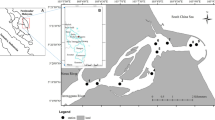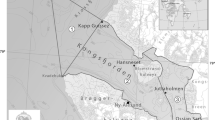Abstract
The Coiba National Park is located off the Pacific coast of Panama andincludes several small islands and a larger one which gives its name to the park. Anumber of rivers in Coiba Island have well developed mangrove systems attheir mouths and two of these were selected for the present study: SantaCruz and El Gambute. The first one comprises an assemblage of Rhizopora mangle, Laguncularia racemosa and Pellicierarhizoporae, and shows no evidence of recent human activity. The secondone is a smaller forest, solely composed of short Rhizoporamangle trees, and is recovering from the impact of human activities.During 1997, the tidal flats associated with each system were studied. Toasses the polychaete distribution within each tidal flat, three transects werearranged from the low to the upper intertidal level. Every transect hadthree sampling sites: the first one was adjacent to the low water level, thesecond one at an intermediate point, and the third one close to the highwater level and the mangrove line. At each site, three randomly chosensamples of sediment were taken for faunal study and a further one wascollected for sedimentology study.The polychaetes were identifiedto species or genus level. For each flat, a matrix summarizing the actualnumber of individuals of each species in every sample was created, andpopulation density, species richness and diversity were computed for eachsite. After matrix data had been transformed, a similarity analysis of thesamples was carried out.
Similar content being viewed by others
References
Alongi, D.M. 1989. Ecology of tropical soft-bottom benthos: a review with emphasis on emerging concepts. Rev. de Biol. Trop. 37: 85–100.
Alongi, D.M. 1990. The ecology of tropical soft-bottom benthos ecosystems. Oceanogr. Mar. Biol. Ann. Rev. 28: 381–496.
Day, J.H. 1975. The mangrove fauna of Morrumbene Estuary, Mozambique. In: Walsh, G., Snedakar, S. and Teas, H. (eds.), Proceedings of the International Symposium on Biology and Management of Mangroves, vol. 2. pp. 415–430.
Dexter, D.M. 1979. Community structure and seasonal variation in intertidal Panamanian sandy beaches. Est. Coast. Mar. Sci. 9: 543–558.
Dittmann, S. 1995. Benthos structure on tropical tidal flats of Australia. Helgol. Meeresuntersuch. 49: 539–551.
Dittmann, S. 1996. Effects of macrobenthic burrows on infaunal communities on tidal flats. Mar. Ecol. Prog. Ser. 134: 119–130.
Ditmann, S. 2000. Zonation of benthic comunities in a tropical tidal flat of north-east Australia. J. Sea Res. 43: 33–51.
Frith, D. W., Tantanasiriwong, R. and Bhatia, O. 1976. Zonation of macrofauna on a mangrove shore, Phuket Island. Phuket Mar. Biol. Cent. Res. Bull. 10: 1–37.
Guerreiro, J., Freitas, S., Pereira, P., Paula, J. and Macia Jr., A. 1996. Sediment macrobenthos of mangrove flats at Inhaca Island, Mozambique. Cah. de Biol. Mar. 37: 309–327.
Hartman-Schröder, G. 1959. Zur Ökologie der Polychaeten des Mangrove-Estero-Gebietes von El Salvador. Beitr. f. neotrop. Fauna 1: 70–183.
Hernández-Alcántara, P. and Solís-Weiss, V. 1991. Ecological aspects of the Polychaete population associated with the red mangrove Rhizophora mangle at Laguna de Términos, Southern Part of the Gulf of Mexico. Ophelia Suppl. 5: 451–462.
Hsieh, H.-L. 1995. Spatial and temporal patterns of polychaete communities in a subtropical mangrove swamp: influences of sediment and microhabitat. Mar. Ecol. Prog. Ser. 127: 157–167.
Hutchings, P.A. and Recher, H.F. 1982. The fauna of Australian mangroves. Proc. Linnean Soc. of NSW. 106(1): 83–121.
Kolehmainen, S.E. and Hildner, W.K. 1975. Zonation of organisms in Puerto Rican red mangrove (Rhizophora mangle L.) swamps. In: Walsh, G., Snedakar, S. and Teas, H. (eds.) Proceedings of the International Symposium on Biology and Management of Mangroves, vol. 1. pp. 357–369.
Larsonneur, M. 1977. La cartographie de depóts meubles sur le plateau continental français. Méthode mise au point et utilisée en Manche. J. Rech. Océanogr 2: 33–39.
Ólafsson, E. 1995. Meiobenthos in mangrove areas in eastern Africa with emphasis on assemblage structure of free-living marine nematodes. Hydrobiologia 312: 47–57.
Reise, K. 1991. Macrofauna in mudflats of tropical and temperate tidal flats. In: Elliot, M. and Ducrotoy, J.-P. (eds.), Estuaries and Coasts: Spatial and Temporal Intercomparisons, pp. 211–216. Olsen and Olsen. Fredensborg, Denmark.
Sasekumar, H.L. 1974. Distribution of macrofauna on a Malayan mangrove shore. J. Animal Ecol. 43: 51–69.
Schrijvers, J., Van Gansbeke, D. and Vincx, M. 1995. Macrobenthic infauna of mangroves and surrounding beaches ata Gazi Bay, Kenya. Hydrobiologia 306: 53–66.
Trask, P.D. 1950. Applied Sedimentation, 707 pp. John Wiley and Sons. NewYork, USA.
Vargas, J.A. 1987. The benthic community of an intertidal mudflat in the Gulf of Nicoya, Costa Rica. Description of the community. Rev. de Biol. Trop. 35: 299–316.
Vargas, J.A. 1988a. Community structure of macrobenthos and the results of macropredator exclusion on a tropical intertidal mud flat. Rev. de Biol. Trop. 36: 287–308.
Vargas, J.A. 1988b. A survey of the meiofauna of an eastern tropical Pacific mud flat. Rev. de Biol. Trop. 36: 541–544.
Vargas, J.A. 1996. Ecologycal dynamics of a tropical intertidal mudflat community. In: Nordstrom, K.F. and Roman, C.T. (eds.), Estuarine Shores: Evolution, Environments and Human Alterations, pp. 355–371. Wiley. Chichester, USA.
Warwick, R.M. and Ruswahyuni, 1987. Comparative study of the structure of some tropical and temperate marine soft-bottom macrobenthic communities. Mar. Biol. 95: 641–649.
Wells, F.E. 1983. An analysis of marine invertebrate distributions in a mangrove swamp in north-western Australia. Bull. Mar. Sci. 33: 736–744.
Author information
Authors and Affiliations
Rights and permissions
About this article
Cite this article
López, E., Cladera, P., San Martín, G. et al. Polychaete assemblages inhabiting intertidal soft bottoms associated with mangrove systems in Coiba National Park (East Pacific, Panama). Wetlands Ecology and Management 10, 233–242 (2002). https://doi.org/10.1023/A:1020179830880
Issue Date:
DOI: https://doi.org/10.1023/A:1020179830880




